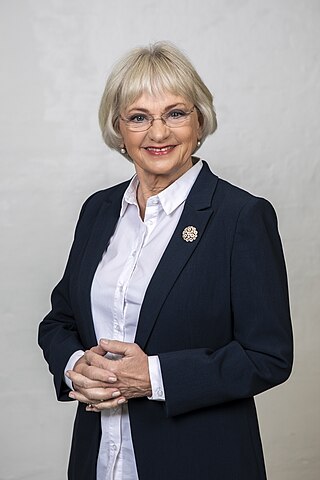
Pia Merete Kjærsgaard is a Danish politician who was Speaker of the Danish Parliament from 2015 to 2019, and former leader of the Danish People's Party.

The prime minister of Denmark is the head of government in the Kingdom of Denmark comprising the three constituent countries: Denmark, Greenland and the Faroe Islands. Before the creation of the modern office, the kingdom did not initially have a head of government separate from its head of state, namely the monarch, in whom the executive authority was vested. The Constitution of 1849 established a constitutional monarchy by limiting the powers of the monarch and creating the office of premierminister. The inaugural holder of the office was Adam Wilhelm Moltke.
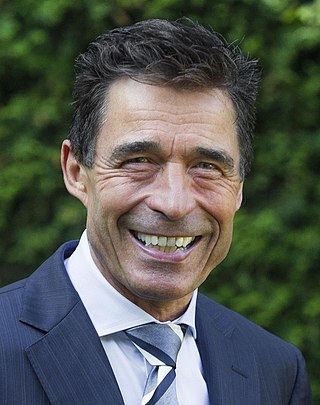
Anders Fogh Rasmussen is a Danish politician who was the prime minister of Denmark from November 2001 to April 2009 and the secretary general of NATO from August 2009 to October 2014. He became founder of political consultancy Rasmussen Global and founded the Alliance of Democracies Foundation. He serves as a senior adviser to Citigroup. He also served as a senior advisor at the Boston Consulting Group.

Venstre, full name Venstre, Danmarks Liberale Parti, is a conservative-liberal, agrarian political party in Denmark. Founded as part of a peasants' movement against the landed aristocracy, today it espouses an economically liberal, pro-free-market ideology.
The Social Democrats is a social democratic political party in Denmark. A member of the Party of European Socialists, the Social Democrats have 50 out of 179 members of the Danish parliament, Folketing, and three out of fourteen MEPs elected from Denmark.
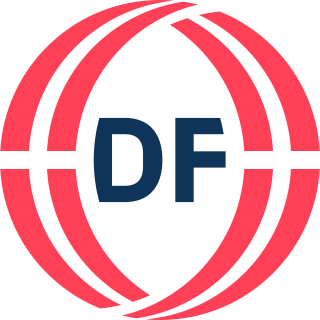
The Danish People's Party is a nationalist and right-wing populist political party in Denmark. It was formed in 1995 by former members of the Progress Party (FrP).

The Folketing, also known as the Parliament of Denmark or the Danish Parliament in English, is the unicameral national legislature (parliament) of the Kingdom of Denmark — Denmark proper together with the Faroe Islands and Greenland. Established in 1849, the Folketing was the lower house of the bicameral parliament called the Rigsdag until 1953; the upper house was the Landsting.

General elections were held in Denmark on 20 November 2001. For the first time since the 1924 elections, the Social Democrats did not win the most seats. Anders Fogh Rasmussen of the centre-right Venstre became Prime Minister in coalition with the Conservative People's Party, as the head of the first Rasmussen government, with the support from Danish People's Party.

General elections were held in Denmark on 8 February 2005. Prime Minister Anders Fogh Rasmussen's Venstre remained the largest party in the Folketing and his governing coalition with the Conservative People's Party remained intact, with the Danish People's Party providing the parliamentary support needed for the minority government. The Danish Social Liberal Party made the biggest gains of any party, although it remained outside the governing group of parties. The elections marked the second time in a row that the Social Democrats were not the largest party in parliament, a change from most of the 20th century. The Social Democrats lost five seats and leader Mogens Lykketoft resigned immediately after the elections. Voter turnout was 85% in Denmark proper, 73% in the Faroe Islands and 59% in Greenland.
The Danish referendum on the Treaty establishing a Constitution for Europe was a planned referendum to be held on 27 September 2005, that would have put the proposed Constitution to the voters of Denmark for ratification. However, after voters voted down the Constitution in both the French and Dutch referendums before the Danish vote could take place, Danish prime minister Anders Fogh Rasmussen indicated that the referendum would be cancelled. On 24 April 2008 the Danish parliament ratified the Treaty's successor, the Treaty of Lisbon, without a referendum.

Helle Thorning-Schmidt is a Danish retired politician who served as the 26th Prime Minister of Denmark from 2011 to 2015, and Leader of the Social Democrats from 2005 to 2015. She is the first woman to have held each post. Following defeat in 2015, she announced that she would step down as both Danish Prime Minister and Social Democratic party leader. Ending her political career in April 2016, she was the chief executive of the NGO Save the Children until June 2019.

Minister for Integration is a Danish ministerial office. The office was created by Prime Minister Anders Fogh Rasmussen on 27 November 2001 when he formed the Cabinet of Anders Fogh Rasmussen I after the 2001 Danish parliamentary election, in which refugees, immigration, and integration of people from non-western countries had been important issues.

The Liberal Alliance is a classical liberal and right-libertarian political party in Denmark. The party is a component of the centre-right bloc in Danish politics. The party's platform is based upon economic liberalism, promotion of tax cuts and reduction of welfare programmes, and a critical, oppositional stance towards European integration.

General elections were held in Denmark on 15 September 2011 to elect the 179 members of the Folketing. Of those 179, 175 members were elected in Denmark, two in the Faroe Islands and two in Greenland.

Denmark holds opt-outs from European Union policies in relation to police and justice and the adoption of the euro. They were secured under the Edinburgh Agreement in 1992 after a referendum for the ratification of the Maastricht Treaty was rejected by Danish voters, as a package of measures to assuage concerns raised during that referendum.
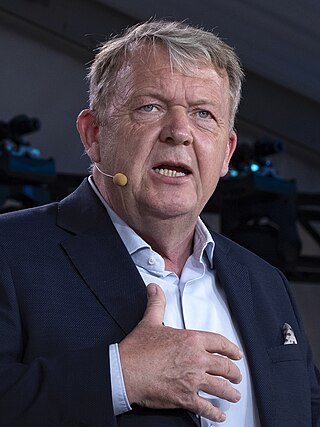
Lars Løkke Rasmussen is a Danish politician who has served as Minister of Foreign Affairs since 2022. He previously served as Prime Minister of Denmark from 2009 to 2011 and again from 2015 to 2019. He was Leader of the Venstre party from 2009 to 2019.

The First cabinet of Lars Løkke Rasmussen, was announced on 5 April 2009 as Lars Løkke became prime minister after Anders Fogh Rasmussen was offered the post of Secretary General of NATO on 4 April 2009.
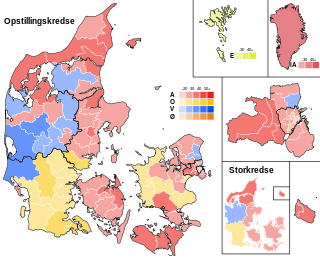
General elections were held in the Kingdom of Denmark on 18 June 2015 to elect the 179 members of the Folketing. 175 members were elected in the Denmark proper, two in the Faroe Islands and two in Greenland. Although the ruling Social Democrats became the largest party in the Folketing and increased their seat count, the opposition Venstre party was able to form a minority government headed by Lars Løkke Rasmussen with the support of the Danish People's Party, the Liberal Alliance and the Conservative People's Party.

The cabinet of Prime Minister Helle Thorning-Schmidt was the cabinet government of Denmark from 3 October 2011 to 3 February 2014. It was a coalition between the Social Democrats, the Danish Social Liberal Party and the Socialist People's Party. On 9 August 2013, Helle Thorning-Schmidt made a cabinet reshuffle and on 12 December 2013, she made a second cabinet reshuffle. The cabinet resigned on 3 February 2014, following the Socialist People's Party left the government on 30 January 2014. It was succeeded by the Cabinet of Helle Thorning-Schmidt II

General elections were held in the Kingdom of Denmark on 5 June 2019 to elect all 179 members of the Folketing; 175 in Denmark proper, two in the Faroe Islands and two in Greenland. The elections took place ten days after the European Parliament elections.





















